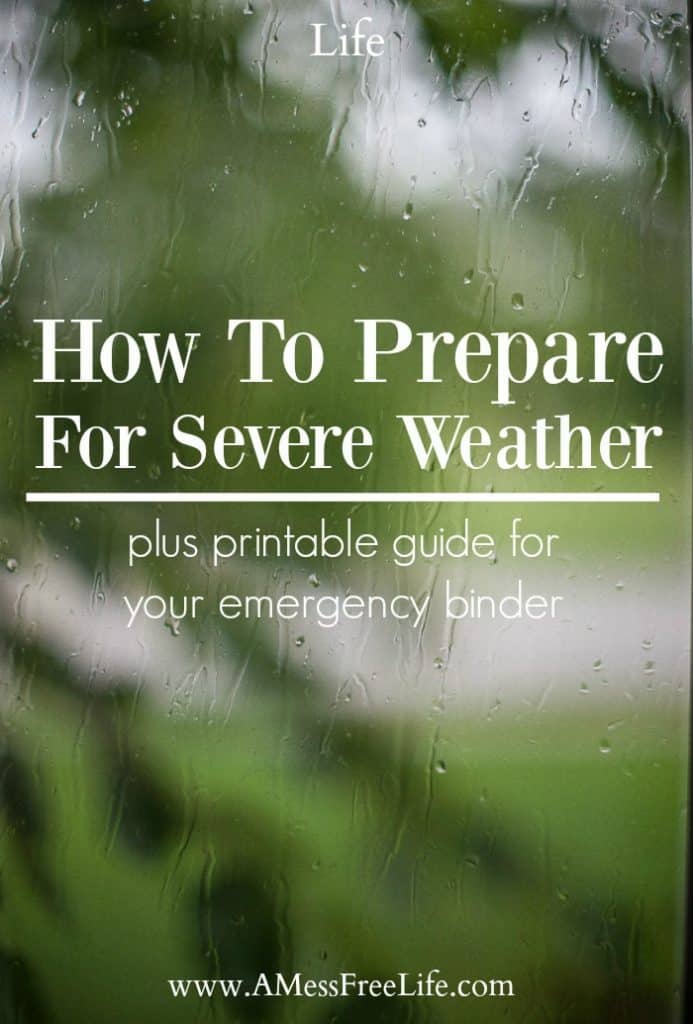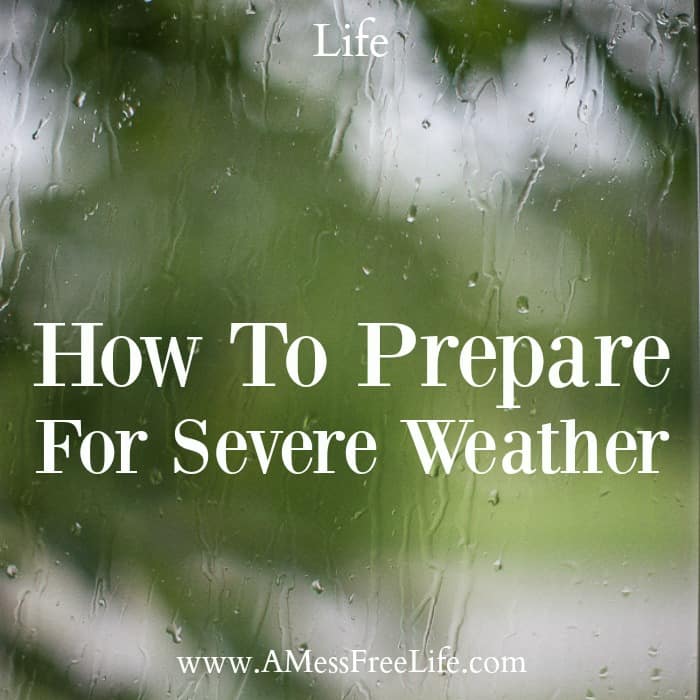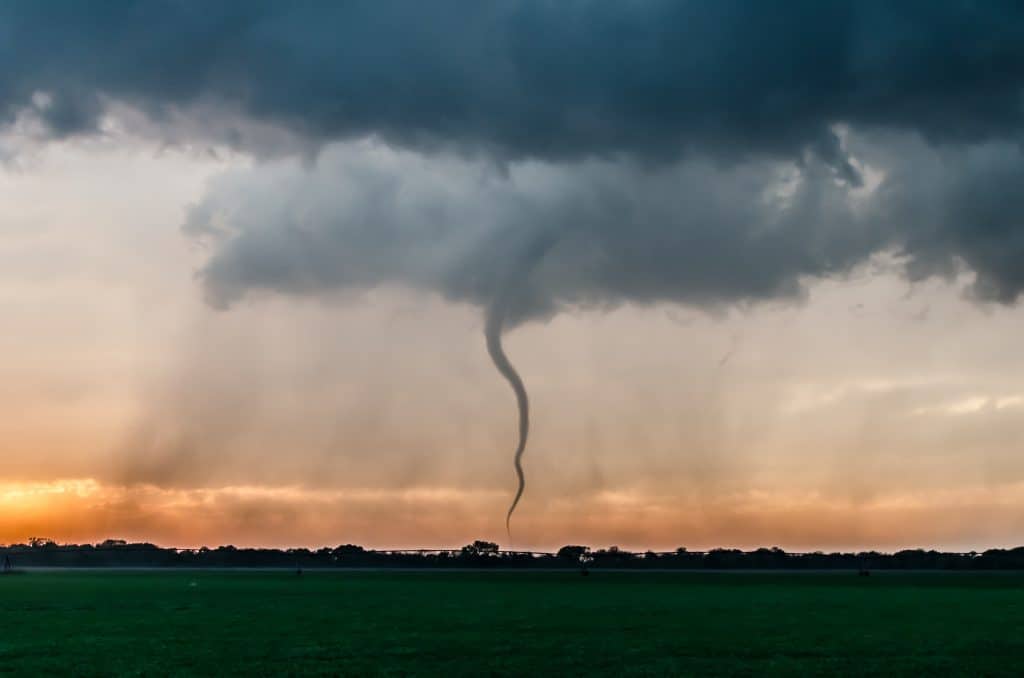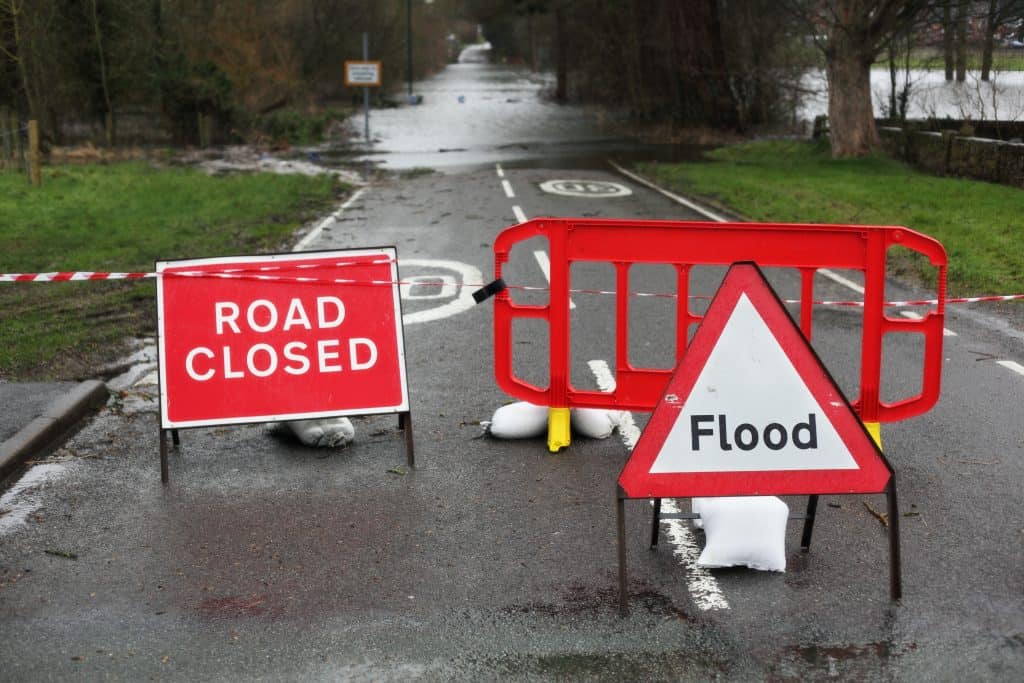A Mess Free Life may collect a share of sales or other compensation from the links on this page.
Spring has sprung and because it has now is the time to learn how to prepare for severe weather.
In most parts of the country, the arrival of spring means the start of the severe weather season. It’s also the time to be alert and pay attention to rapidly changing weather conditions. Severe thunderstorms with lightning, heavy rain, hail, high winds, and even tornadoes are possible during this time of year.
Here in the northeast, we have started to see more severe weather that includes hail, damaging winds, tornadoes and lots of lightning. All thunderstorms produce lightning, and all have the potential for significant danger.
In the United States, lightning kills 300 people and injures around 80 each year. Because of lightning’s unpredictability to cause injury and destroy property, preparedness is crucial to minimizing harm. Lightning often strikes outside of heavy rain and may occur as far away as 10 miles ahead of or after the storm. Most deaths, as a result of a lightning strike, occur when people are caught outdoors and are unaware of the impending danger. The typical thunderstorm is 15 miles in diameter and produces heavy rain anywhere from 30 to 60 minutes. They can occur singly, in clusters or lines.
Additionally, severe thunderstorms can produce tornadoes; mother nature’s most violent weather event. They can appear without warning and can be invisible until dust and debris are picked up and swirled around, or a funnel cloud appears.
Damage from severe weather can result in devastating damage to buildings, massive tree damage, downed wires, closed roads and sudden flooding. The aftermath of severe weather can last days, weeks and even months to towns or regions.
As with all disasters, preparedness, monitoring the media and common sense can minimize the danger to you and your family. This manual is designed to show you how to prepare for severe weather and reduce the risks to you and your family.
Table of Contents
How To Prepare For Severe Weather
Become Familiar With the Terms Forecasters Use To Identify Types of Severe Weather
Flash Flood Warning: Flash flooding is in progress, imminent, or highly likely. Seek higher ground immediately or evacuate if directed to do so.
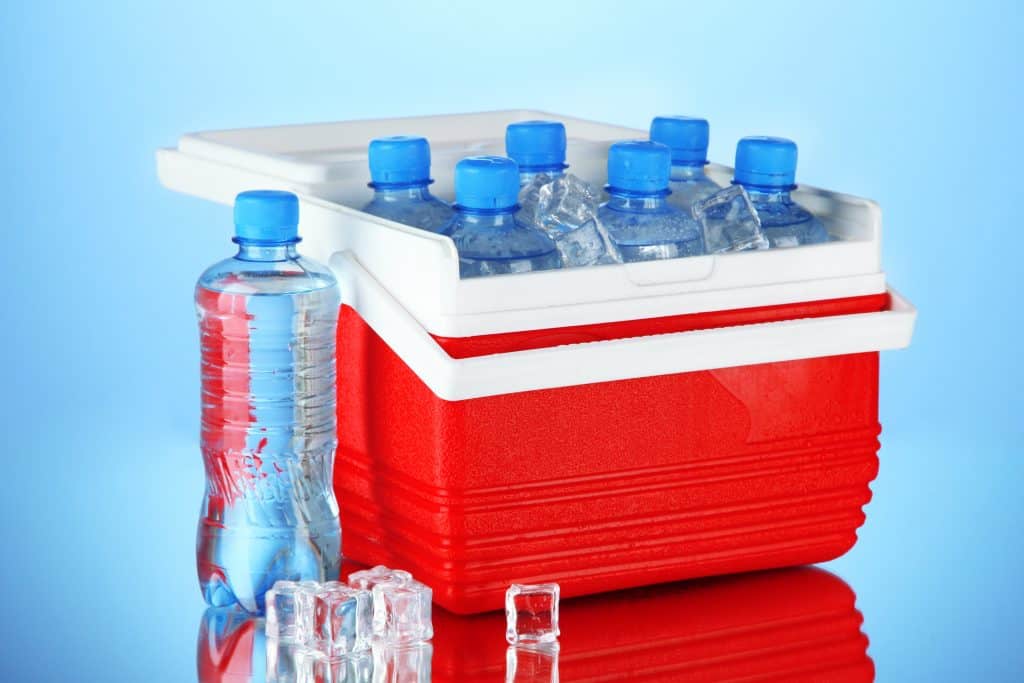
What You Should Have On Hand At Home In Case Severe Weather Strikes
• Bottled Water: Have at least a 3-day supply of water on-hand. A good rule of thumb is one gallon per person per day. This provision of water can be used not only for drinking but for sanitation purposes, too. If you store bottled water at home make sure you rotate your stock and use before the expiration date.
• Food: Keep at least a 3-day supply of non-perishable food readily available. Think easy-to-prepare foods that require little or no prep work, such as canned fruits and vegetables, canned meats and soups. Energy bars, nuts, and granola are also good choices.
• Manual Can Opener: If you don’t have power, you’ll need one to open your canned food.
• Flashlight: Should you experience a power failure, a flashlight is a must. Have extra batteries on-hand.
• First-aid kit: If you haven’t already purchased or created a first-aid kit, find out what to include by visiting The American Red Cross website and learn what your first-aid kit should include. Check the kit regularly for expiration dates, and replace any used or out-of-date contents.
• Battery-powered or hand-crank radio: Even if you own a smartphone, you may lose power during a severe weather situation and will be unable to charge it. Because of this, it’s important to have either a battery-powered or hand-crank radio (for listening to local emergency instructions) or National Oceanic and Atmospheric Administration (NOAA) weather radio receiver (for listening to National Weather Service broadcasts).
• Money In the Form of Cash: If electricity is down, ATM’s and banks will have no way to give you money. Keeping cash on hand ensures you’ll have funds if you need it.
• Prescription Medications and Glasses: Consider buying a pill container and having an extra supply of medicines available for emergencies.
• Infant Formula, Diapers, and Food: Make sure you have the necessary food and water for babies and small children
• Pet Food and Water: Pets are part of the family too, right? Make sure you can meet the needs of your pets in an emergency.
• Cell Phones with Chargers, Inverter or Solar Charger: You’ll want a way to connect with others if there is cell phone service.
Related articles on Preparedness:
Food Storage Survival Tips #NatlPrep
Water Storage Tips for Emergency Preparedness #NatlPrep
September is National Preparedness Month #NatlPrep
Additional Items To Consider Having On Hand To Prepare for Severe Weather
• Whistle to signal for help
• Toilet paper
• Pocket knife
• Local maps
• Dust mask, to help filter contaminated air along with duct tape and plastic sheeting to shelter-in-place
• Wrench or pliers to turn off utilities
• Moist towelettes, garbage bags and plastic ties for personal sanitation
• Important family documents such as copies of identification, passports, insurance policies, bank account records in a waterproof, portable container
• Sleeping bag or warm blanket for each person in your family. You might want extra bedding if you live in a cold-weather climate.
• Warm packs and camp heater.
• Change of clothing for each family member, which includes a long-sleeved shirt, long pants, and sturdy shoes. You might want extra clothing if you live in a cold-weather climate.
• Water purification tablets
• Household bleach and medicine dropper – to use as a disinfectant. Dilute nine parts water to one part bleach. To treat water in an emergency, use 16 drops of regular household liquid bleach per gallon of water. Do not use scented, color safe or bleaches with added cleaners.
• Fire Extinguisher
• Waterproof matches or regular matches kept in a waterproof container
• Long-Burning candles
• For your personal hygiene, feminine supplies, and personal items
• Paper cups, plates and plastic utensils, paper towels, mess kits, paper and pencils
• Activities for children, such as books, games, and puzzles.
It doesn’t take much to gather the supplies you need.
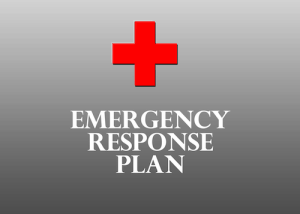
Make Sure You Develop Your Plan
A few years ago, I had this nagging feeling we would experience a tornado that summer. I got me thinking about what I would do if we had an alert for a tornado and how I would protect not only myself but my elderly mother who suffers from dementia.
I thought about this for some time and came up with a plan of how I would get her into the basement and then protect her with cushions and blankets and how I would secure her so she wouldn’t get sucked up in a funnel cloud, never to be seen again.
Some of my friends thought I was crazy, but lo and behold, several weeks later, we did indeed have a tornado in Massachusetts. Luckily it didn’t strike our neck of the woods, but I’ve never forgotten my plan and last year when a tornado warning was issued for my part of the state, I had my plan in place and was ready to implement it.
Planning for these types of events ensures you know what you’ll do if you are caught in a severe weather situation.
Here are some other things to consider:
First, discuss the types of disasters that are most likely to occur in your area. For example, I don’t live in a flood area, and it would be highly unlikely that my home would ever be threatened by flood waters. My daughter, on the other hand, does live in a flood area and has a plan if her home were to flood. Make sure you evaluate the risk for where family members work and children go to school.
Once you understand your risks, gather the family and develop your plan.
Emergency Planning: Your Family Evacuation Plan
Start with an evacuation plan for your home and then determine an evacuation route. Here’s how:
- Draw up a floor plan with two escape routes for each room. Make sure children know the ways. If one route is out a window make sure you have an appropriate exit device to aid in leaving the second floor.
- Establish a place to meet outside the house and have alternate meeting locations in the neighborhood.
- Have a full tank of gas, proper clothing, disaster supplies, relevant documents, and a supply of cash ready to go with you.
- If possible, secure your home as best you can.
- Make sure you have a map of your community with all emergency evacuation routes.
Emergency Planning: Family Communication
- Agree on an out-of-town contact in case local communications are down.
- Make a family contacts’ card for each family member with contact information.
- Program “ICE” (In Case of Emergency) contacts in all of your cell phones.
- In an emergency, go to the Red Cross Website, where you can register yourself as safe and also search for family members.
- Sign up for community alert services that will send you instant text or e-mail alerts for local emergencies.
Determining If You Should Shelter At Home or Not
In most cases when severe weather strikes, staying at home and taking the necessary precautions will be the best choice possible for you and your family. Always follow the instructions given by emergency personnel. If you are asked to leave, follow the guidance of local fire and police.
During Severe Weather:
Auto Safety Tips:

After the Storm Has Passed
Preparedness is not something that is static; it is ever-changing.
Putting your plan in place will not only protect your family in the event of severe weather but when other disasters strike.
